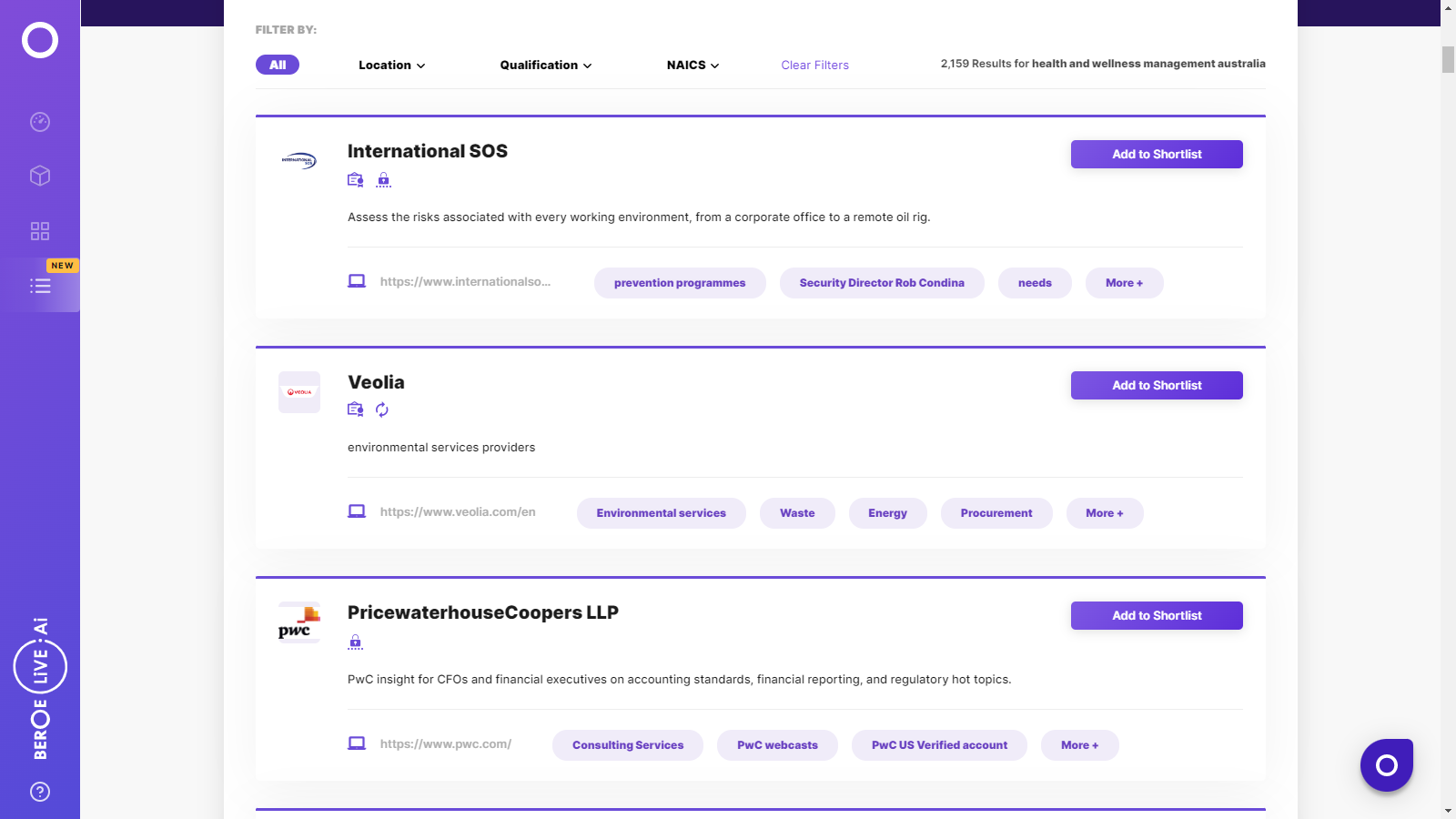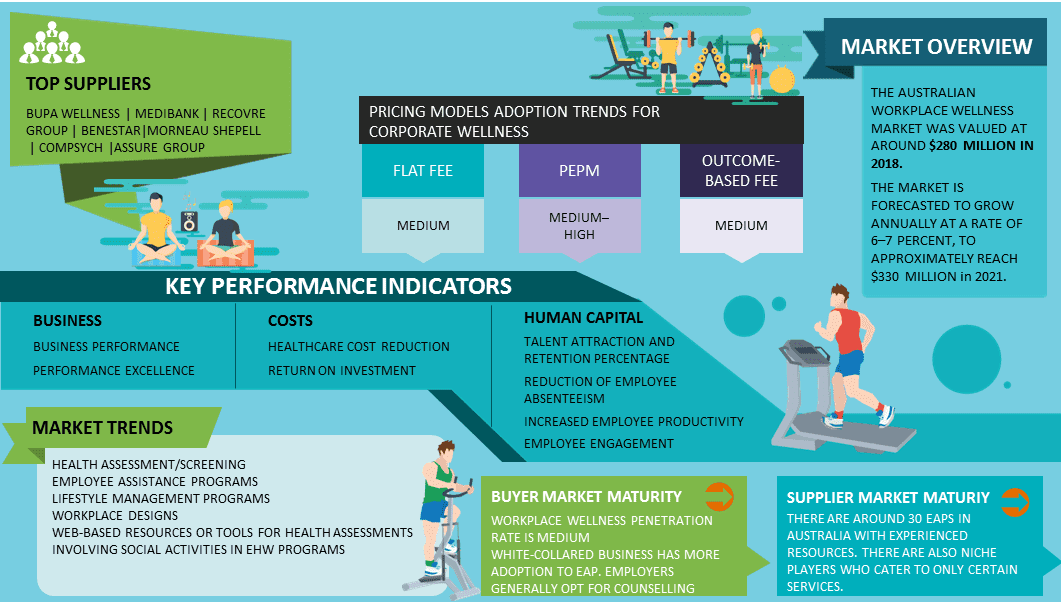CATEGORY
Health and Wellness Management Australia
Beroe LiVE.Ai™
AI-powered self-service platform for all your sourcing decision needs across 1,200+ categories like Health and Wellness Management Australia.
Market Data, Sourcing & Supplier Intelligence, and Price & Cost Benchmarking.
Schedule a DemoThe World’s first Digital Market Analyst
Abi, the AI-powered digital assistant brings together data, insights, and intelligence for faster answers to sourcing questions
Abi is now supercharged with GPT4 AI engine. Enjoy the ease of ChatGPT, now on Abi
Health and Wellness Management Australia Suppliers

Find the right-fit health and wellness management australia supplier for your specific business needs and filter by location, industry, category, revenue, certifications, and more on Beroe LiVE.Ai™.
Schedule a Demo


Use the Health and Wellness Management Australia market, supplier and price information for category strategy creation and Quaterly Business Reviews (QRBs)
Schedule a DemoHealth and Wellness Management Australia market report transcript
Regional Market Outlook on Health and Wellness Management
- The employee assistance and wellness services industry revenue is around $280 million in 2018, and it is expected to grow at a rate of 6–7 percent by 2021
- Around 56 percent of employers are offering health promotion to employees in Australia
- Global players are extending their service capabilities to different states in Australia, with the main focus on reducing absenteeism in workplace
- During 2000s, the federal and state government in Australia subsidized the cost of corporate wellness programs. So, the corporate wellness market started to grow
- However, during 2013–2014, the cancellation of health initiatives by the government led to the decline of revenue in the industry and also the industry participation
- Currently, corporate wellness is slowly growing, employers focus more on employer assistance programs, the reason being workplace stress causes absenteeism and surveys show that the direct cost to employers was found to be around AUD 16 billion per year on stress and employee mental issues
- Sickness and absenteeism cost organizations an estimated $2,700 per employee each year as per Australian Bureau of Statistics

Australia Corporate Wellness Industry Trends
- Employers in Australia are promoting wellness initiatives to attract, retain talent, improve employee engagement and productivity, reduced injuries and sick days
- Wellness programs are becoming an important component of the health insurance market, as the insurers are trying to reduce the health services utilization and claim cost
- Lifestyle practices, occupational health, and safety are given high importance by companies
Corporate Wellness Drivers and Constraints
- Increase in work-related health issues, stress, absenteeism, and government regulations are driving the growth of employee wellness programs. Employers also use this as a tool to retain and attract talent, improve employee engagement, productivity, and to maintain work ability
Drivers
Occupational health and safety
- Costs related to work-related stress is increasing and absenteeism is increasing. Traditionally, health and wellness have been focused on minimizing the risk of physical hazards in a workplace, but for the past few years, this has been changing to incorporate broader psychosocial considerations, health plans, and employee assessment and assistance programs
Human capital and brand image of organizations
- Health education, health screenings, and disease management have helped reduce absenteeism and employee turnover as well as increase productivity and efficiency
- Brand image includes talent attraction, retention, and ideas about broader corporate social responsibility
Government regulations
- The Work Health and Safety (WHS) Act, Work Health and Safety Regulation 2011
- Work Health and Safety Regulation 2017 (NSW) – There are different state specific laws that concentrate and insist on health and well being of people. The government also provides few subsidies to employers for having corporate wellness programs
Constraints
Involvement of employees
- Employers find it difficult to involve all of their employees in wellness and assistance program participation. In Australia, the number of employees having access to EAP program is increasing, but the utilization rate is found to be around 5 percent
- Rewards and incentive systems are growing, so as to increase the participation of employees
Lack of support from management as well as budget and resource constraints
- Resource constraints, such as lack of staff, a regular on-site doctor, coach consulting facilities and budget, are among the most prevalent reasons for not having a wellness program in place (in the organizations)
Health and Wellness Management Australia Market Overview
- Australia has got around 30 identifiable regional EAPs and few wellness players
- Suppliers require well-experienced psychologist for EAP.
- For health checks, clinical services are required. Suppliers require doctors, nurses, fitness trainers, nutritional trainers, and technology to have a comprehensive wellness program
- The bargaining power of suppliers can be considered from low to medium, as they have to always provide the best resources to their buyers by consolidating all resources
- The main buyers of EAP and EHW programs are insurance and financial services and other business services
- Employees having access to EAPs and EHWP are increasing
- Employers have higher bargaining power when they look only for EAP, but a low to medium bargaining power if they are looking for EAP and EHWP together
- The major market share of EAP and EHWP is shared by a few major players
- Rivalry can be attributed to medium to high for EAP because existing small players are growing to become medium-sized firms
- Some players dominate niche segments or niche markets
- The threat of substitution will be medium as better individual counsellors, coaches and low-budget medical services can take the place of corporate wellness programs that would require a high budget
- Employers can go for individual services as and when needed
- The wellness industry is steadily growing. This growth will bring more suppliers into the emerging market with innovative products
- Barriers to entry are low to medium and the industry is growing
Why You Should Buy This Report
- Information about the Australian health and wellness market overview, maturity, industry trends, technological trends, drivers and constraints, etc.
- Regional market outlook, industry outlook and Porter’s five forces analysis of the Australian health and wellness market.
- Supplier trends and insights, profiles of key suppliers
- Cost structure, cost breakup, sourcing models, pricing models, KPIs, etc.
Interesting Reads:
Discover the world of market intelligence and how it can elevate your business strategies.
Learn more about how market intelligence can enable informed decision-making, help identify growth opportunities, manage risks, and shape your business's strategic direction.
Get Ahead with AI-Enabled Market Insights Schedule a Demo Now
